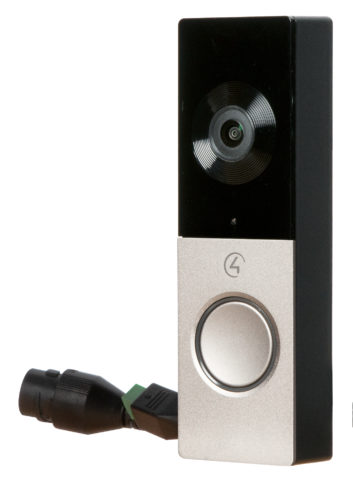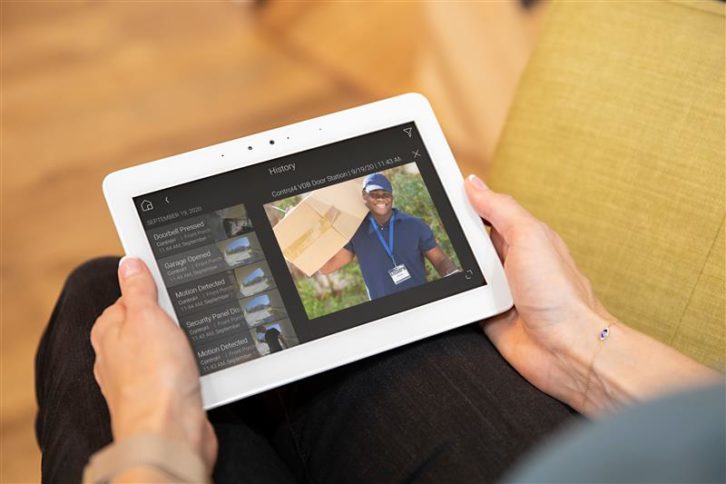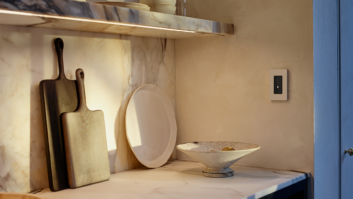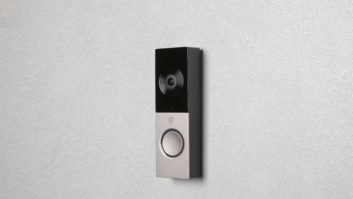
Take a walk through a typical neighborhood and you’ll quickly notice that one of the leading smart home accessories is the smart doorbell. Instead of the dumb push-to-contact relay and ding-dong chime people have lived with since, I don’t know, the dawn of time, many homeowners are adding smart devices to their front porch from the likes of Google, Ring, Arlo, and a host of others. Even security companies like Vivint, ADT, and SimpliSafe are offering solutions.
Undeniably, the smart doorbell is a hot category, but you know what all of these lack? Any kind of deep integration with the automation systems that we’re installing. Or, as Control4’s senior director of product marketing Kordon Vaughn said, “Video doorbells let you see and talk, but not do.”
Roughly two years ago, Control4 launched its new DS2 Door Station. This device screams luxury all the way, with a gorgeous looking faceplate available in three solid metal finishes that fit right in outside a million-dollar home and offers solid Control4 integration, as well as the addition of a new Control4 feature, “Intercom Anywhere.” But, at nearly $1200 for the flush-mount version, it can be a tough sell for many customers, especially when there are plenty of DIY options available for under $200. And, even at that premium pricing, the DS2 had a pretty meager 1280×960 (1.2 MP) resolution camera compared to many competing products, didn’t capture/record any video clips, and required a hardwired Ethernet cable for PoE power, meaning retrofit was often out of the question.
Due to this, it’s likely you’ve been incorporating other products with third-party drivers (nod to Blackwire Designs!) into your Control4 projects to get some kind of smart doorbell integrated with your installs, even if it meant the customer bouncing between apps.
Control4 has heard your cries and feels your pain, and better yet, they are doing something about it! Meet the new Chime Video Doorbell, which Control4 calls “the first video doorbell solution designed to leverage all of the capabilities of the sophisticated Control4 OS3.”
Related: Control4 Smart Home OS 3 Review
First Impressions
Let’s get this out of the way upfront: Chime is way cheaper than DS2. While not cheap at $400, it is far more affordable, and comes with the kind of dealer margin you’d never dream of getting with DIY stuff. Chime also comes in two versions: PoE for new installs and Wi-Fi for retrofits, both offered in black or nickel metallic finishes.
Taking Chime out of the box, my first thought was, “Man, this is dinky.” Chime measures a scant 5 x 1.5 x 1 inches (H x W x D) — about 60 percent the size of a dollar bill — and it’s pretty light. Visually, it’s modern and attractive, but it definitely doesn’t exude the weight and gravitas of the DS2. (But if you’ve got a customer who is really sensitive about the look at the front door, the DS2 is still available!)
Chime’s front is basically divided into two halves, with the camera lens on top and the button on bottom. The button is ringed with a soft-lit LED that is white during regular operation, making it obvious where to push. If enabled, two red LEDs glow on either side of the lens at night to enhance dark viewing. It comes with a simple metal mounting bracket that attaches to the wall with two screws, and then the Chime clips and secures into the bracket with an Allen-screw into the bottom.
Since I was replacing a DS2 with an existing hardwired Cat cable connected to a Pakedge PoE switch, I opted for the PoE version. For retrofit installs where you’re replacing an existing doorbell, the Wi-Fi version will likely be your go-to since it powers via the existing doorbell’s transformer and 2-wire connection. (The PoE version also has the ability to connect to an existing door chime or contact sensor.)
If you go with the PoE version, be aware that it has a pretty thick waterproof Ethernet connector hanging off the back that requires some fair wire management space behind it, and mounting this to a solid surface like brick or concrete will mean chiseling out a pocket for this wiring to recess into. Control4 will offer a new construction box that is a half-gang size that accepts the Chime mount, as well as an adapter plate for single-gang wall boxes. There isn’t a flush-mount option with Chime.
For my install, I fabricated a piece of plastic to cover the existing DS2 opening, with a hole for the wiring to tuck through into the DS2 recessed mount, and simply attached the Chime mount with a couple of screws.
With the PoE version, that’s it for the install. With the Wi-Fi version, once it is wired and powered up, you need to connect it to the home’s Wi-Fi. Chime creates an ad-hoc Wi-Fi network you connect to — navigate a web browser to 192.168.1.1 and you’ll enter the default password and then scan and connect to the home’s Wi-Fi. Chime supports both 2.4 and 5 GHz signals, and Control4 recommends a target signal of at least –65 dBm at the door station for reliable performance.
Once on the network, you open your new version of Composer OS3.2 and Chime announces itself via SDDP. Drag it into your project, and after it performs any firmware updates, you’re instructed to change its admin password before you can proceed.
Related: Perception of Doors
In Use
After that, you have access to the Chime’s properties, which are far more extensive than what the DS2 offered and don’t require opening a separate web page to access. Here you can adjust things like what call group it notifies when the doorbell is pressed, make image setting adjustments (white balance, brightness, contrast, saturation, sharpness), night mode and exposure settings, set the resolution of the camera’s video stream, configure network settings (including whether to use DDNS), create up to five separate motion zones, set privacy masking, and select what kind of events to capture during motion or when the button is pressed.
Immediately noticeable is the vastly improved image quality of Chime’s 5 MP (2560×1920) camera compared to the DS2. Where images on the DS2 were a bit flat and soft, Chime captures sharp, vibrant, saturated, and detailed snapshots and videos. Chime currently captures video clips for Control4 interfaces at resolutions up to 1600×1200 (or 1024×768 for on-screen), but you can see its full image quality by either logging into its Web GUI or linking it to an ONVIF-capable NVR for higher-resolution (and full-time) recording. The camera boasts a super-wide 180-degree field of view that will likely cover most installations, but Control4 will offer two mounting wedges to further angle/aim Chime if need be.
The microphone is also quite sensitive, not only perfect for two-way conversations with whomever is on your doorstep, but also picking up the sounds of chatter and kids playing out in the street.
With OS3 integration, the home can now automatically react when Chime senses motion or when the doorbell is pressed, with all the programming and if/then customizations you want to employ based on things like time of day, whether the security system is armed or not, if the home is in stay or away mode, etc.

The five configurable motion zones can be independently programmed for different actions per motion in each zone; say the driveway motion turning on floodlights if it is night time and arming the security system if it is after a certain time of day, and have the porch motion turning on porch lights and making sure the door is locked.
You can also have push notifications sent to a device when motion is sensed in any zone. For example, I often get packages delivered where the driver never presses the doorbell button, but now I’m notified there was motion at the door and I am prompted to check who/what caused it. (We captured one late night video of a gnarly Kaiju cricket slowly crawling past Chime’s lens.)
One of OS3.2’s great new features is a new “History” icon that gives you information about security events around the home. This presents a timeline of when the doorbell sensed motion or the doorbell button was pressed, what time doors locked/unlocked, and when the security system armed/disarmed. Doorbell videos and snapshots are stored for seven days, with all other history saved for 14 days. (4Sight subscription is required for the 7-day cloud video storage.) You can also easily share or save an event, snapshot, or video by pressing and holding it; making it simple for a homeowner to archive or share something with the authorities. Also nice is that you can enable a time/date stamp for all snapshots and recordings.
The separate Intercom Anywhere app was introduced with the DS2, and you’ll recall it freed your phone from the doorbell, letting you also take calls from touchscreens, and letting you call touchscreens from phones when away from home. Another boon of OS3.2 is that the separate IA app is going away, now merged in as part of the Control4 app. (Note: Merged apps will be available for Android devices at launch; iOS version is awaiting final approval from Apple and will launch later this year.)
An intercom icon in OS3.2 brings up all of the intercom features, letting you control everything from within one app. Another recent update treats incoming intercom calls as a regular phone call, letting you answer audio only, or jump straight into video intercom mode. OS3.2 also features improvements to let Chime work with multi-home systems, correctly contacting you from any location.
Chime is also now OvrC-enabled, giving pros the ability to remotely monitor system status, receive notifications, and reboot it if required from the OvrC web or mobile app. (An OvrC Pro device — like an Araknis router or OvrC Pro Hub — is required for remote access.)
Charlie Kindel, SnapAV’s chief product and technology officer, perfectly sums it up by saying, “Chime marries security and automation to a level that has never been done before. It’s entirely customizable, transforming the doorbell’s role in the smart home to deliver the experience homeowners want.”
In other words, Chime will likely become the de facto smart doorbell solution on your Control4 projects going forward, as well as offering a terrific conversation starter to add killer integration to any existing jobs.
888-400-4070; Control4.com
Kudos: Great image quality; easily share/save videos/snapshots; simple installation/setup
Concerns: None
Product Specs:
- Smart doorbell solution designed for Control4 OS3
- Available in PoE and Wi-Fi versions
- Offered in Black and Satin Nickel metallic finishes
- 5 MP camera (2560×1920) with 180-degree field of view
- Five selectable motion detection zones allow for notification or event triggering in Control4 programming
- Motion events, video clips, and snapshots stored in Cloud for seven days and can be shared or saved to client device
- ONVIF video stream can be added to NVR for recording/playback
- Intercom Anywhere and cloud video storage requires 4Sight subscription
Dimensions:
5 x 1.5 x 1 inches (H x W x D)



